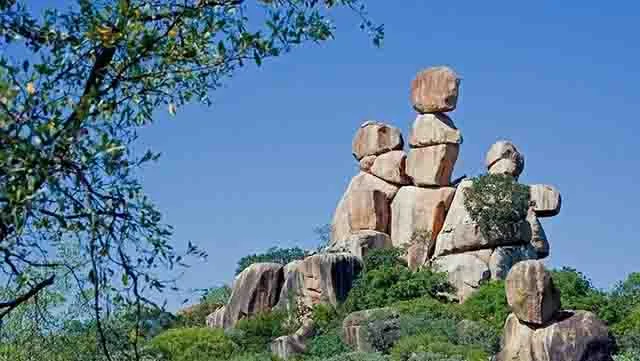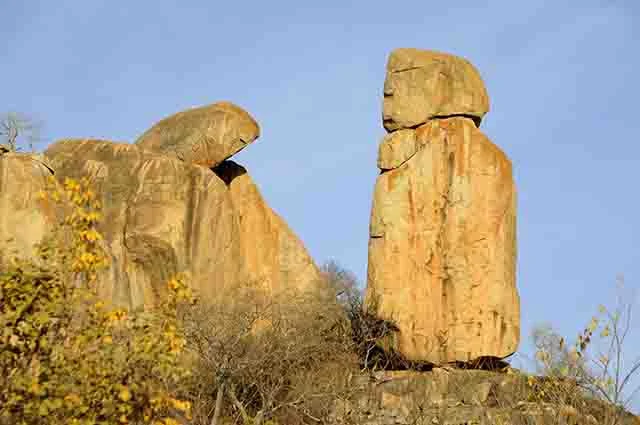Matobo Hills. One of the most beautiful natural attractions in Zimbabwe , declared a World Heritage Site in 2003 by the UNESCO.
The Matobo Hills are a geological formation in the form of heaps of granite boulders on top of each other in the form of columns or pillars in Zimbabwe. Currently, the Matobo area is a national park and is included in the UNESCO World Heritage List.
 |
| Matobo Hills Unesco |
The hills were discovered by Cecil Rhodes, a politician who persuaded the government to colonize the land, which was named Rhodesia after him. This is where Cecil Rhodes was buried. The history of the formation of these hills, towering over a granite shield, goes back 3.5 billion years, when the Earth was an inhospitable place. During strong eruptions, entire lakes of molten material accumulated in these areas, which later solidified and cracked. Over billions of years, erosion has eroded and exposed these remnants, leading to the formation of the outlandish Matobo landscape.
Amazing rock formations - granite boulders lying one on top of the other in an unthinkable balance - are found everywhere. Archaeologists believe that this is the result of volcanic activity, weathering and washing out of soft rocks. Alternative sources believe that the hands of the giants, who built fancy pyramids of stones, also touched the balancing stones.
 |
| Matobo Hills Unesco |
One of the most beautiful places in Zimbabwe is Malindijimu hill. The top of this granite monolith, where giant boulders are frozen, which are about to roll, but do not roll, is also called the Hill of Spirits and the Picture of the World. And this unearthly picture of the world is fascinating. For the local peoples - Shona and Ndebele - Malindijimu has been a sacred hill since ancient times, religious rituals were held here.
Cecil Rhodes was buried here in 1902. He ordered a resting place in advance. On the back slope of the hill, another memorial is the mass grave of 34 British from the Shangani (Wilson) patrol, defeated by the Ndebele tribes in 1893. The cemetery of the European invaders does not please the locals. In 2012, Zimbabwean farmers even approached President Robert Mugabe with a proposal to exhume the remains of Rhodes, which they believed caused a drought in the country, and send them to the UK to restore the disturbed balance. It didn't work out. But the boulders are standing, keeping the cosmic balance of the picture of the world.
 |
| Matobo Hills Unesco |
The Matobo Hills are the " megalithic analogue "of Greater Zimbabwe. Huge blocks of granite, bursting into the light from under the earth's crust, split in the most bizarre way, creating amazing sculptures that carry echoes of the elements and time. Thousands of square kilometers of rearing land... Matobo - "Bald Hills".
The Matobo hills are sacred to local tribes as a place of worship for spirits. The large rock formations of Matobo served as natural shelters for ancient man, from the early Stone Age until the beginning of our era. Here is the richest collection of rock art, which tells about the past centuries and millennia.
The huge hills of Matobo keep the secrets of more than one millennium. In the rocks and hills, travelers see each their own: the crown of the emperor and the trident, the back of a huge whale and the walls of a magical castle, the head of a dog, a rabbit... Everything here is filled with mystery... This fantastic landscape enchants and bewitches.
 |
| Matobo Hills Unesco |
No wonder this place is considered sacred. Everything here breathes mystery, magic and power. Sacred hills have long aroused mystical awe among the locals. And the peaks of Shumba, Shaba and Shumba Sham are not only considered sacred, but are also surrounded by a strict taboo: local residents categorically do not advise climbing their peaks. This is a great sin, and anyone who violates the ban will be severely punished - an endless series of failures and misfortunes awaits him.
Matobo National Park is considered one of the most beautiful and mysterious places on our planet. If you look at Matobo from a bird's eye view, it will resemble a huge eagle. Perhaps this is an accident, but rather rare black eagles do live in the reserve. And besides them - owls, hawks and about 300 more species of birds. Rhinos, both black and white, also feel good here, as well as giraffes, zebras, leopards, hippos and many other animals.
Life has been in full swing around the reserved hills since ancient times. Scientists tend to believe that people have lived here for at least 40 thousand years. And the work of the last of them - the Bushmen - can be seen today. On ancient rocks with special paints, ancient people depicted hunting and fires, rituals of worshiping the gods and everything that worried them. These drawings are 20 thousand years old. No wonder the reserved hills are considered a mysterious and sacred place.